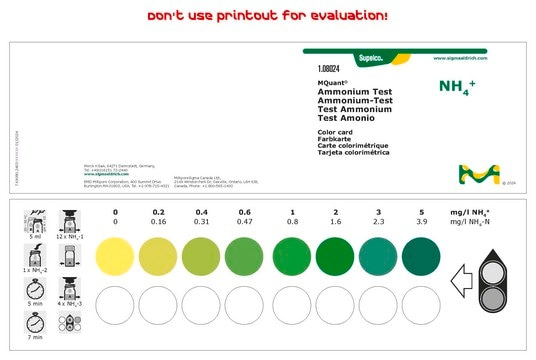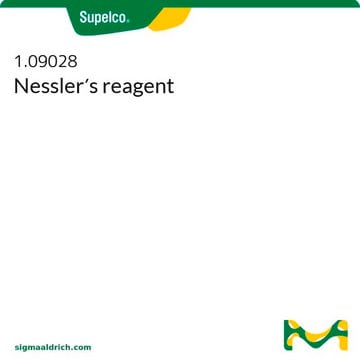Products may be shipped at a different temperature than the recommended long-term storage temperature. If the product quality is sensitive to short-term exposure to conditions other than the recommended long-term storage, it will be shipped on wet or dry-ice. If the product quality is NOT affected by short-term exposure to conditions other than the recommended long-term storage, it will be shipped at ambient temperature. As shipping routes are configured for minimum transit times, shipping at ambient temperature helps control shipping costs for our customers. For more information, please refer to the Storage and Transport Conditions document: https://www.sigmaaldrich.com/deepweb/assets/sigmaaldrich/marketing/global/documents/316/622/storage-transport-conditions-mk.pdf
MAK310
Ammonia Assay Kit
sufficient for 200 fluorometric tests
Sinonimo/i:
Ammonia Quantitative Test Kit
Scegli un formato
Scegli un formato
About This Item
Prodotti consigliati
Metodo di rivelazione
fluorometric
Malattie correlate
genitourinary disorders; gastrointestinal diseases
Temperatura di conservazione
−20°C
Categorie correlate
Descrizione generale
Caratteristiche e vantaggi
Compatibilità
Principio
Avvertenze
Danger
Indicazioni di pericolo
Consigli di prudenza
Classi di pericolo
Acute Tox. 4 Oral - Aquatic Acute 1 - Aquatic Chronic 1 - Eye Dam. 1 - Skin Corr. 1B - Skin Sens. 1
Codice della classe di stoccaggio
8A - Combustible corrosive hazardous materials
Punto d’infiammabilità (°F)
188.6 °F
Punto d’infiammabilità (°C)
87 °C
Scegli una delle versioni più recenti:
Certificati d'analisi (COA)
Non trovi la versione di tuo interesse?
Se hai bisogno di una versione specifica, puoi cercare il certificato tramite il numero di lotto.
Possiedi già questo prodotto?
I documenti relativi ai prodotti acquistati recentemente sono disponibili nell’Archivio dei documenti.
I clienti hanno visto anche
-
How is shipping temperature determined? And how is it related to the product storage temperature?
1 risposta-
Utile?
-
-
How can I determine the shelf life / expiration / retest date of this product?
1 risposta-
If this product has an expiration or retest date, it will be shown on the Certificate of Analysis (COA, CofA). If there is no retest or expiration date listed on the product's COA, we do not have suitable stability data to determine a shelf life. For these products, the only date on the COA will be the release date; a retest, expiration, or use-by-date will not be displayed.
For all products, we recommend handling per defined conditions as printed in our product literature and website product descriptions. We recommend that products should be routinely inspected by customers to ensure they perform as expected.
For products without retest or expiration dates, our standard warranty of 1 year from the date of shipment is applicable.
For more information, please refer to the Product Dating Information document: https://www.sigmaaldrich.com/deepweb/assets/sigmaaldrich/marketing/global/documents/449/386/product-dating-information-mk.pdfUtile?
-
-
What is the composition of reagent A and reagent B supplied with the MAK310 assay kit?
1 risposta-
The exact percentages as exact reagent composition are proprietary. The composition can be provided in ranges as follows; Reagent A: Contains 1-15% o-phthalaldehyde, CAS #: 643-79-8, and 10-99% dimethyl sulfoxide, CAS#: 67-68-5. Reagent B: Contains 0.1-5% β-Mercaptoethanol, CAS#: 60-24-2, and 10-99% dimethyl sulfoxide, CAS#: 67-68-5.
Utile?
-
-
Can i use this assay kit to determine the ammonia amount of culture media sample? (RPMI-1640)
1 risposta-
This kit has not been tested for use with cell culture samples or supernatants, including those containing RPMI-1640. Amine-containing buffers such as Tris buffers should be avoided. In addition, high protein concentrations may interfere with the reaction. The end user would have to determine suitability. Product MAK538, Ammonia Assay Kit, would be a more suitable product for use in cell culture applications. Please see the link below to review this product option:
https://www.sigmaaldrich.com/product/sigma/mak538Utile?
-
-
What is the recommended protocol for the storage and freeze/thaw of the ammonia assay kit (MAK310)? Is it permissible to aliquot portions in advance, or is the kit stable for a certain period of time at 4°C? Furthermore, what is the optimal method for thawing the kit (on ice)? Additionally, what is the shelf life of the reagents once thawed? Should the thawed "working" reagents be stored at 4°C or room temperature until they are used (within the timeframe of the above question)?
1 risposta-
It is advisable to aliquot portions of the reagents in advance to minimize the number of freeze-thaw cycles. Thawing the components at room temperature is acceptable. But, there is no specific data available regarding the stability of the reagents once they are thawed. It is recommended to prepare smaller aliquots of the reagents, enough for the number of assays the customer intends to run, to avoid having an excessive amount of reagent after an experiment. While it is acceptable to refreeze the leftover aliquots for future use, it is advisable to minimize multiple freeze-thaw cycles. The reagents may be temporarily stored at 4°C if necessary during an experiment. Additionally, it is recommended to create a standard curve according to the protocol, and if the curve is linear, then the kit should be functioning properly.
Utile?
-
-
Can this kit chemistry be used directly with serum samples, or will the protein content interfere with the assay?
1 risposta-
The kit chemistry cannot be used directly with serum samples. Deproteinization is necessary before running the assay, and this can be achieved by passing the sample through 10 kDa cutoff filters. Alternatively, proteins can be chemically precipitated using TCA, although this method has not been tested with this kit. If using acid for protein separation, it is important to neutralize the sample with a base before running the assay.
Utile?
-
-
To calculate the molarity of my samples, do I need to multiply it by the dilution factor of the final reaction volume? According to technical bulletin, standards are diluted 1/10 at final molarity of .1 mM at the highest point of the curve.
1 risposta-
If 10 uL of undiluted sample is used before adding the 90 uL of working reagent, then no dilution factor is needed. The dilution factor is only needed if the sample has been diluted before the pipetting for 10 uL into the sample well. For example, if the kit is used and the ammonia concentration is 1 mM or greater, it is necessary to dilute the sample in water and repeat the assay. Multiply the results by the dilution factor. If the sample is diluted 10-fold, then a dilution factor of '10' would need to be applied to the results.
Utile?
-
-
Is this a stand alone test or does it require external instrumentation?
1 risposta-
A 96 well plate is not included in this kit. A plate reader is also required. Please see the 'Reagents and Equipment Required but Not Provided with this kit' on the Product Information Sheet:
https://www.sigmaaldrich.com/deepweb/assets/sigmaaldrich/product/documents/196/522/mak310bul.pdfUtile?
-
-
Is this kit suitable for seawater samples?
1 risposta-
Yes, the Ammonia Assay Kit provides a simple and high throughput adaptable assay for quantitative determination of ammonia/ammonium ion concentration in biological samples, such as urine, and environmental samples.
Utile?
-
Filtri attivi
Il team dei nostri ricercatori vanta grande esperienza in tutte le aree della ricerca quali Life Science, scienza dei materiali, sintesi chimica, cromatografia, discipline analitiche, ecc..
Contatta l'Assistenza Tecnica.












